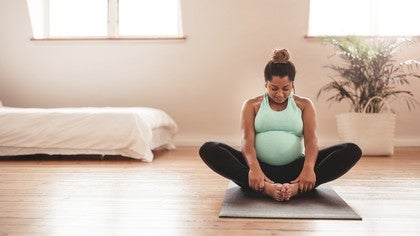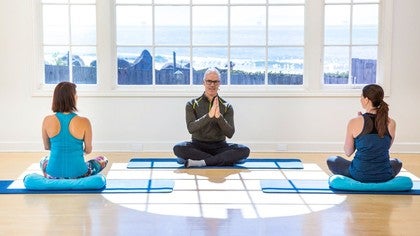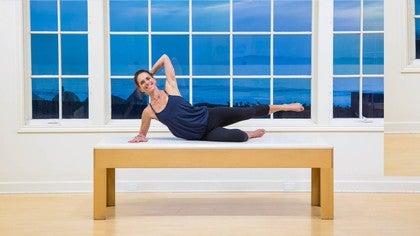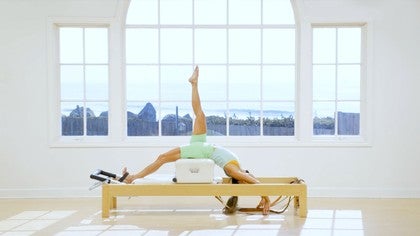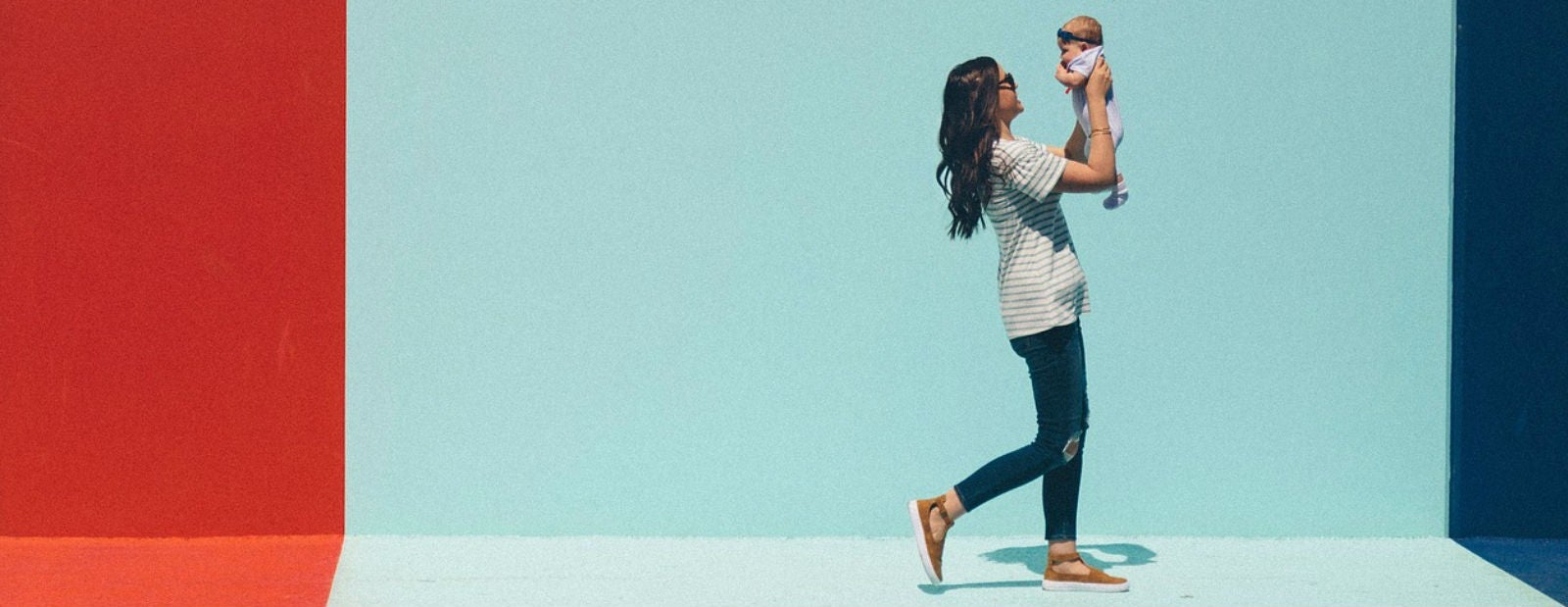
Your Postpartum Pilates Q's, Answered
Now that baby has arrived, life has shifted from being all about you — and let’s face it, your belly — to being all about your swaddle-clad newborn. Between the ’round-the-clock feedings and constant diaper changings, not to mention the sleep deprivation you’re experiencing (the struggle is real), your life as a new mom probably means your “me” time is at an all-time low. To make matters worse, you’re dealing with unpredictable hormonal fluctuations (it’s like PMS on steroids) and pains in places you never knew you had. Translation: You need some self-care more than ever.
Enter postpartum Pilates, which is designed specifically to help you through this deeply taxing time. “You’ve just experienced a major event, physically, mentally, and emotionally, and now you’re starting from a new place,” says Leah Stewart, MS, of LiveLifePilates in Costa Mesa, CA. “It’s a place of honor — we’re honoring that our body has to go through a long healing period.
“Moms have limited time, and they want to feel like they’re getting progress. With Pilates, we can accomplish this safely and make the process both enjoyable and empowering.”
Your Beginner Reformer Pilates Guide
When can I start?
Although most experts advise waiting six to seven weeks to begin working out, Leah says there are things that you can — and should — do sooner.
“I’m a strong believer that breath work and a focus on rejuvenation should be happening within hours of giving birth,” she says. “Within a couple of days, it’s a good idea to use that Pilates breath with pelvic floor and abdominal muscle visualization exercises.” Leah also suggests doing some light pelvic work, like rocking the pelvis back and forth and doing little circles, to promote mobility and circulation.
Another helpful hint from Leah: “I encourage moms to ask for a 20-minute mini Pilates session, to learn gentle movements they can practice at home and set up a plan to progress back to the traditional Pilates work.” Can’t make it to the studio? Ask your teacher to make you a video, or try a short Skype session.
What are some of the benefits of postpartum or postnatal Pilates?
Pilates is one of the most versatile, adaptable exercise methods on the planet. “Pilates can be anything that it needs to be for that person, for that particular phase of life,” says Leah. “A great Pilates teacher understands the intention behind the exercises, and how to modify them for the new mom without aggravating any symptoms like diastasis recti.” (More on diastasis in a bit.) For example, a new mom should not be doing the traditional Hundred, but she can do it in a seated position with her spine in C curve.
Leah also points to Pilates’ focus on alignment and posture, which is especially important for the postpartum mom. “Pilates corrects the misalignment of pregnancy and also the physicality of being a new mom, with all those demands being placed on her posture with holding her baby, nursing and so forth.”
Stress relief is another biggie. “Pilates is great for grounding and self-care. The intentional deep breathing we do oxygenates the muscles and the brain, giving us more mental clarity and patience. We learn to take that step back when things get hard with a newborn experiencing colic or not latching on.” PSA: That oxygenation, coupled with the increased circulation you get from movement, is also what gives you increased energy, something that’s needed more than ever when you’re a sleep-deprived new mom.
Last but not least, the awareness that Pilates teaches pays off in dividends. “When we have movement incorporated into our life, we touch base with our body and that awareness seeps out into our life. And, there’s that feeling of, I’ve done something good for myself. Motherhood is all about putting someone else first, which is beautiful, but when you can say, I made my self-care a priority, that’s huge.”
What are the best postpartum Pilates exercises?
Here are some of Leah’s favorite postnatal core strength exercises and more that you can do anywhere, anytime:
Pelvic Tilt/Curl (aka Bridge) This exercise safely hits on everything, from the pelvic floor/abdominal connection to the hips, spine and upper abdominals. “When done correctly, you get a beautiful release on the muscles you just contracted,” she adds.
Half Roll-Back “If a woman feels comfortable enough to sit on her tailbone, I love this exercise in a seated position to open up the chest, engage the spinal extensors and target the upper body.”
Shoulder and Chest Openers Start lying down (even on your bed!) with your arms in a T position, and open and close your arms. Then, try it in a seated position, on a mat, a ball or the edge of the Reformer carriage. Finally, progress to a standing position with added resistance (such as a band or a light weight).
A word to the wise: Avoid back-extension exercises like Swan and Swimming right off the bat. “If a mother has a forward kyphotic posture [think: hunched shoulders, rounded back] caused by holding her baby and has full breasts, she needs to open up chest and shoulders first - a precursor to back work. Back extension is not going to be as beneficial until she corrects the misalignment and releases the muscles.”
Can Pilates help with post-pregnancy conditions, like diastasis recti or incontinence? What about postpartum depression?
Yes, yes and...probably.
When it comes to diastasis recti and urinary incontinence, two major issues women face post pregnancy, Leah says Pilates affords us the opportunity to heal those conditions.
“When you have a diastasis recti, you have an excessive widening and thinning of the linea alba, the tissue on the right and left side of the abdominals,” Leah explains. “When we correctly activate the abdominals [in postpartum Pilates], we are supporting that contraction and the regeneration of the muscle tissues that were completely stretched out during pregnancy. We shy away from traditional flexion (exercises with your head and neck up) since it places too much load on abdominals and pelvic floor.”
Urinary incontinence for the new mom, which can be as much of a physical issue as it is emotional, tends to be related to the pelvic floor muscles, which need to heal after baby. “There’s an element of incontinence that’s natural after pregnancy. In Pilates, it’s about reactivating the pelvic floor, releasing the tight muscles and rebuilding from there. We’re setting the foundation to support the stresses of exercise,” Leah explains. “Pilates is so successful because we work in so many different ranges of motion and positions, so we’re able to work the pelvic floor in its entirety in a really healthy way.” Another PSA: Healing the pelvic floor is key to sexual health.
As for postpartum depression, “Anecdotally, I can say that Pilates helps,” Leah offers. “Based off experiences with clients, it can help with the highs and lows from all of those hormone influxes.” Movement and exercise make you feel good, both physically and mentally, she adds.
Is Pilates good for C-Section Recovery
“Yes, because it promotes blood flow and oxygenation, which helps to heal damaged muscles like the transverse abdominis and the obliques,” Leah explains. “Pilates also works on the nerve connection and making connections with the brain, which is essential for the natural healing process.”
Any last tips for new moms in terms of their Pilates practice?
Check in with yourself and set goals. Try to identify what you need and what you want that day. Ask yourself, what are my goals, what do I need? Start small: Maybe you have lower-back pain. Maybe you don’t want to pee in your pants. Then, progress to those bigger goals, e.g., looking a certain way.
Be adaptable. For women who love structure, we quickly learn as moms things can be unpredictable. Try to have a backup plan for when you can get your Pilates in. Can’t get in the 50-minute postpartum Pilates Reformer session? Do 15 minutes on the mat and you’ll still get plenty of benefits.
Comments


You need to be a subscriber to post a comment.
Please Log In or Create an Account to start your free trial.



